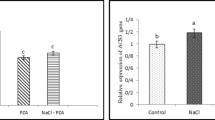Abstract
Ethylene production in leaf petiole and laminae tissues was stimulated in tomato (Lycopersicon esculentum Mill. cv. UCT5) plants exposed to salinity-stress. At the highest salinity level (250 mM NaCl), rates of ethylene production more than doubled over those observed in non-stressed plants. Correspondingly, petiolar epinasty increased with increasing levels of stress impositions. Both responses were suppressed when either 1 mM α-aminooxyacetic acid (AOA), or 100 μM Co2+ was simultaneously applied. Co2+, but not AOA, had a pronounced effect on ethylene production resulting from the application of a saturating dose (2 mM) of 1-aminocyclopropane-1-carboxylic acid (ACC), the immediate precursor of ethylene. This result suggests that ethylene production is dependent upon the activity of ethylene forming enzyme (EFE). The magnitude of ethylene stimulation in leaf petioles was related to the salinity level imposed and to the induction of petiole epinasty. In the absence of stress impositions, epinastic responsiveness to ethylene or its precursor, ACC, might provide a simple, indirect criteria to adjudge salt-sensitivity among plants.
Similar content being viewed by others
References
Abeles FB (1973) Ethylene in Plant Biology. New York: Academic Press
Adams DO and Yang SF (1979) Ethylene biosynthesis: Identification of 1-amino-cyclopropane-1-carboxylic acid as an intermediate in the conversion of methionine to ethylene. Proc Natl Acad Sci 76: 170–174
Amrhein N and Schneebeck D (1980) Prevention of auxin-induced epinasty by α-aminooxyacetic acid. Plant Physiol 49: 62–64
Appelbaum A and Yang SF (1981) Biosynthesis of stress ethylene induced by water deficit. Plant Physiol 68: 594–604
Bradford KJ and Yang SF (1980) Xylem transport of 1-aminocyclopropane-1-carboxylic acid, an ethylene precursor, in water logged tomato plants. Plant Physiol 65: 322–326
Bradford KJ, Hsiao TC and Yang SF (1982) Inhibition of ethylene synthesis in tomato plants subjected to anaerobic root stress. Plant Physiol 70: 1503–1507
Chrominski A, Khan MA, Weber DJ and Smith BN (1986) Ethylene and ethane production in response to salinity stress. Plant Cell Env 9: 687–691
Craker LE and Fillatti JJ (1982) Development of a test-tube stress-ethylene bioassay for detecting phytotoxic gases. Env Pollution 28: 265–272
Crocker W, Zimmerman PW and Hitchcock AE (1932) Ethylene-induced epinasty and the relation of gravity to it. Contrib Boyce Thompson Inst 4: 177–218
El-Beltagy AS and Hall MA (1974) Effect of water stress upon endogenous ethylene levels in Vicia faba. New Phytol. 73: 47–60
El-Beltagy AS and Hall MA (1979) Basic elements for possible new technique to screen for plants relatively tolerant to water stress. Egypt J Hort 6: 261–267
Epstein E, Norlyn JD, Rush DW, Kingsburg RW, Kelley DB, Cunningham A and Wrona AF (1980) Saline culture of crops: A genetic approach. Science 210: 399–404
Garcia FG and Einset JW (1983) Ethylene and ethane production in 2,4-D treated and salt treated tissue cultures. Ann Bot 51: 287–295
Greenway H and Munns R (1980) Mechanisms of salt-tolerance in nonhalophytes. Ann Rev Plant Physiol 31: 149–190
Hall MA (1977) Ethylene involvement in senescence processes. Ann Appl Biol 85: 424–428
Hall MA, Kapuya JA, Sivakumaran S and John A (1977) The role of ethylene in the responses of plants to stress. Pestic Sci 8: 217–223
John RA, Charteris A and Fowler LJ (1978) The reaction of amino-oxyacetate with pyridoxal phosphate-dependent enzymes. Biochem J 171; 771–779
Jones RA (1986) High salt tolerance potential in Lycopersicon species during germination. Euphyt 35: 575–582
Jones RA (1987) Genetic advances in salt-tolerance. In: DJNevins and RAJones, eds. Tomato Biotechnology, pp. 125–137. New York: AR Liss, Inc
Jones RA, Hashim M and El-Beltagy AS (1988) Developmental responsiveness of salt-tolerant and salt-sensitive genotypes of Lycopersicon. In: E Whiteheadet al., eds. Arid Lands: Today and Tomorrow, pp. 765–772. Colorado: Westview Press
Jones RA and Qualset CO (1984) Breeding crops for environmental stress tolerance. In: GBCollins and JFPetolino, eds. Applications of genetic engineering to crop improvement, pp. 305–340. The Netherlands: Nijhoff/Junk
Kawase M (1974) Role of ethylene in induction of flooding damage in sunflowers. Plant Physiol 31: 29–38
Kimmerer TW and Kozlowski TT (1982) Ethylene, ethane, acetaldehyde and ethanol production by plants under stress. Plant Physiol 69: 840–847
Kurth E, Jensen A and Epstein E (1986) Resistance of fully imbibed tomato seeds to very high salinities. Plant Cell Env 9: 667–676
Lynch J, Cramer GR and Lauchli A (1987) Salinity reduces membrane-associated calcium in corn root protoplasts. Plant Physiology 83: 390–394
Maas EV and Hoffman GS (1977) Crop salt-tolerance—Current assessment. J irrig Drain Div (Am Soc Civil Engineers) 103: 115–134
Mehlhorn H and Wellburn AR (1987) Stress ethylene formation determines plant sensitivity to ozone. Nature 327: 417–418
Rush DW and Epstein E (1976) Genotypic responses to salinity differences between salt-sensitive and salt-tolerant genotypes of the tomato. Plant Physiol 57: 162–166
Tal M and Shannon MC (1983) Salt-tolerance in the wild relatives of the cultivated tomato: Responses of Lycopersicon esculentum, L. cheesmannii, L. peruvianum, Solanum pennellii and F1 hybrids to high salinity. Aust J Plant Physiol 10: 109–117
Tingey DT (1980) Stress ethylene production—A measure of plant response to stress. HortSci 15: 630–633
Yang SF (1985) Biosynthesis and action of ethylene. Hort Sci 20: 41–45
Yu YB and Yang SF (1980) Biosynthesis of wound ethylene. Plant Physiol 66: 281–285
Author information
Authors and Affiliations
Additional information
Research supported by AID contract II, NEB-1070-A-00-2074-00.
Rights and permissions
About this article
Cite this article
Jones, R.A., El-Abd, S.O. Prevention of salt-induced epinasty by α-aminooxyacetic acid and cobalt. Plant Growth Regul 8, 315–323 (1989). https://doi.org/10.1007/BF00024662
Received:
Accepted:
Issue Date:
DOI: https://doi.org/10.1007/BF00024662




